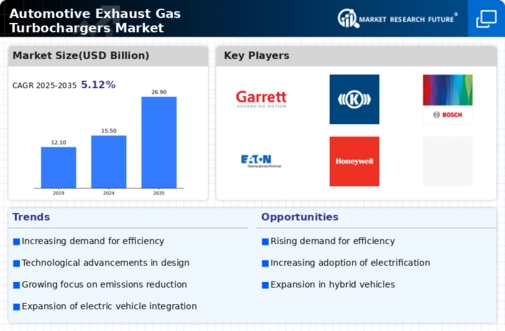Stringent Emission Regulations
Stringent emission regulations imposed by governments worldwide significantly impact the Global Automotive Exhaust Gas Turbochargers Market Industry. These regulations aim to reduce greenhouse gas emissions and improve air quality, compelling manufacturers to adopt cleaner technologies. Turbochargers are instrumental in achieving these goals, as they enable engines to produce more power with less fuel, thereby lowering emissions. Countries such as those in the European Union and the United States have implemented rigorous standards that necessitate the use of advanced turbocharging systems. As a result, the demand for turbochargers is expected to rise, aligning with the industry's commitment to sustainability and compliance with regulatory frameworks.
Rising Demand for Fuel Efficiency
The Global Automotive Exhaust Gas Turbochargers Market Industry experiences a notable surge in demand driven by the increasing emphasis on fuel efficiency. As consumers and manufacturers alike prioritize sustainability, turbochargers enhance engine performance while reducing fuel consumption. This trend is evidenced by the projected market value of 15.5 USD Billion in 2024, reflecting a growing preference for vehicles equipped with turbocharged engines. Furthermore, regulatory frameworks worldwide are tightening emissions standards, compelling automakers to adopt technologies that improve fuel efficiency. Consequently, the integration of turbochargers is becoming a standard practice in modern automotive design, positioning the industry for substantial growth.
Growing Performance Vehicle Segment
The Global Automotive Exhaust Gas Turbochargers Market Industry is witnessing growth in the performance vehicle segment, driven by consumer preferences for high-performance cars. Enthusiasts increasingly seek vehicles that offer superior acceleration and power, leading manufacturers to incorporate turbochargers into their designs. This trend is particularly evident in the sports car and luxury vehicle markets, where turbocharged engines provide a competitive edge. As automakers respond to this demand, the market for turbochargers is likely to expand, supported by the increasing availability of performance-oriented models. The integration of turbocharging technology not only enhances vehicle performance but also aligns with the industry's broader goals of efficiency and sustainability.
Increasing Adoption of Electric Vehicles
The Global Automotive Exhaust Gas Turbochargers Market Industry is also influenced by the rising adoption of electric vehicles (EVs). While traditional internal combustion engines have dominated the market, the shift towards electrification presents both challenges and opportunities for turbocharger manufacturers. Hybrid vehicles, which combine internal combustion engines with electric propulsion, often utilize turbochargers to enhance performance and efficiency. This trend is anticipated to contribute to the market's growth, as the projected value reaches 26.9 USD Billion by 2035. As automakers increasingly integrate turbocharging technology into their hybrid models, the industry is likely to adapt and innovate to meet evolving consumer preferences.
Technological Advancements in Turbocharger Design
Technological innovations play a pivotal role in shaping the Global Automotive Exhaust Gas Turbochargers Market Industry. Recent advancements in materials, such as lightweight alloys and advanced coatings, enhance the durability and efficiency of turbochargers. These innovations allow for higher boost pressures and improved thermal efficiency, which are crucial for meeting stringent emissions regulations. For instance, variable geometry turbochargers are gaining traction due to their ability to optimize performance across various engine speeds. As manufacturers continue to invest in research and development, the market is expected to witness a compound annual growth rate of 5.12% from 2025 to 2035, indicating a robust trajectory fueled by technological progress.












